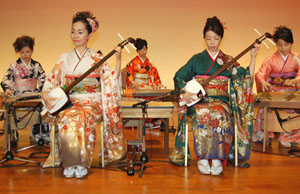 The music that is found in the country of Japan constitutes a great range of performing artists in different styles. This includes both the modern and the traditional styles. Ongaku in Japanese means music. It is a combination of kanji with the kanji ("gaku" music). One of the largest music markets in the world is in Japan. It has a total retail value of 4,096.7 million dollars and the market is dominated mostly by the Japanese artists.
The music that is found in the country of Japan constitutes a great range of performing artists in different styles. This includes both the modern and the traditional styles. Ongaku in Japanese means music. It is a combination of kanji with the kanji ("gaku" music). One of the largest music markets in the world is in Japan. It has a total retail value of 4,096.7 million dollars and the market is dominated mostly by the Japanese artists.
The local music can be found to be appearing at karaoke venues. This is on the lease from the record labels. The traditional Japanese music is much varied from the Western music. This is based on the intervals of the breathing of the human rather than the mathematical timing.
Shomyo is the oldest form of the traditional Japanese music. Buddhist chanting and gagaku, orchestral court music dates back to the Nara and Heian periods.
Another kind of classical music that was performed since the times of the Heian rule at the Imperial court is Gagaku. Azuma-asobi, Kagura-uta and Yamato-uta are some of the relatively indigenous repertories. Togaku and komagaku had their origins in the Chinese Tang dynasty via the Korean peninsula. In addition to this, gagaku is further divided into kangen which is the instrumental music and the other part is bugaku.
 Honkyoku originated as early as the thirteenth century. These are the solo and single shakuhachi pieces which are played by a mendicant Fuke sect priest of Zen Buddhism. Komuso was the name of the priests who played the Honkyoku for enlightenment and alms. The Fuke sect ceased to exist in the 19th century. However a verbal and written lineage has its continuity even today. This music is now often seen to be played in a concert or performance setting.
Honkyoku originated as early as the thirteenth century. These are the solo and single shakuhachi pieces which are played by a mendicant Fuke sect priest of Zen Buddhism. Komuso was the name of the priests who played the Honkyoku for enlightenment and alms. The Fuke sect ceased to exist in the 19th century. However a verbal and written lineage has its continuity even today. This music is now often seen to be played in a concert or performance setting.
The samurai have been found to be listening and performing in these music activities. This helps in the enriching of their lives and understanding.
Puppet theater is another kind of Japanese theater. This is called Bunraku. The traditional theater has its roots in the popular traditions and this flourished during Chonin in the Edo period (1600-1868). This is usually accompanied with the recitation accompanied by shamisen music.